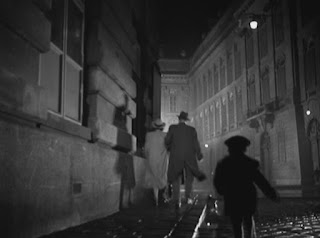Often regarded as one of the best films ever made, the 1949 classic The Third Man is a perfect example of early film noir. Joseph Cotton stars as Holly Martins, a failing pulp writer called to war-torn Vienna with a job offer by his friend Harry Lime (played by Orson Welles). After Holly arrives, it comes to light that Harry has apparently been killed in a car crash. As he interrogates the witnesses, holes in the story of how (and if) Harry was ran down begin to surface, and Holly starts to suspect that all is not as it seems. With the reluctant help of Harry’s lover, Anna (Alida Valli), Holly delves into the darkest corners of Vienna in a quest to find the truth. Welles’ performance as Harry Lime, much like his various other cinematic appearances, is extremely mem
orable and well-orchestrated. The film won the Grand Prize of the 1949 Cannes Film Festival, the 1950 BAFTA Film award for best British film and the 1951 Oscar for best cinematography in the Black & White category.

 The Third Man is a prime example of film noir, and contains various shots displaying conventional characteristics of thrillers, this including the mystery-driven plot. As the film opens to the Third Man Theme on zither, as the initial voiceover from Major Cal
The Third Man is a prime example of film noir, and contains various shots displaying conventional characteristics of thrillers, this including the mystery-driven plot. As the film opens to the Third Man Theme on zither, as the initial voiceover from Major Cal loway (Trevor Howard) describes the divided city, the seedy goings on about Vienna become clear. A flourishing post-war black market is hinted visually by the iconic image of the selection of watches; illegal and underground activity is at the centre of countless plots in thrillers. The expected plain and unforgiving view of death and violence is also glimpsed from the get-go; a body drifts in the tide beside the river Wien, signifying the dilapidated state of the city.
loway (Trevor Howard) describes the divided city, the seedy goings on about Vienna become clear. A flourishing post-war black market is hinted visually by the iconic image of the selection of watches; illegal and underground activity is at the centre of countless plots in thrillers. The expected plain and unforgiving view of death and violence is also glimpsed from the get-go; a body drifts in the tide beside the river Wien, signifying the dilapidated state of the city. Apart from content, the shots in the film also subtly connote stereotypical assets of thrillers. The use of angles in Martins and Holloway’s conversation are very effective. The canted angle and over-shoulder pieces clearly show a conversation is taking place, confusion mounting in Holly’s mind. Holly is seen at a low angle to the man on the staircase when he arrives at Harry’s apartment, as he has no grasp of his surroundings or his peers’ languages; he is a stranger in a strange land. Shadows are utilised throughout the film; Harry is presented as if he is the Yang to Holly’s Ying. Shadows and silhouettes appear to follow Holly, constantly watching his investigation. Black comedy is also included in the ever-so-slightly menacing little boy as he chases Anna and Holly through the streets. The most famous sequence is that of the
sewer scene. The city appears to be a maze, Harry darting in and out of crevices like a cornered rodent. The rule of thirds is applied to focus our attention on Harry’s futile attempts to escape, and Chiaroscuro lighting bathes the waterways.


A promising analysis thus far but obviously incomplete. It is important Jack that you complete the post in order to achieve a grade that reflects your knowledge and understanding of film language.
ReplyDelete